EDEC 203: EYLF-Aligned Lesson Plan for Number Recognition Skills
VerifiedAdded on 2023/06/04
|5
|1373
|468
AI Summary
This document presents a lesson plan designed for early childhood education, specifically targeting number recognition skills in children aged 3-8. The plan, aligned with the Early Years Learning Framework (EYLF), focuses on enhancing children's cognitive development, mathematical understanding, and confidence in exploring numbers. The lesson incorporates a math-rich environment with resources like whiteboards and pencils, employing explicit teaching strategies and differentiation techniques to cater to diverse learning needs. Assessment methods include evaluating children's ability to count and recognize number sequences. The reflection emphasizes the use of scaffolding and visualization to promote engagement and systematic learning. Future planning involves enhancing writing skills and fostering a positive attitude towards math learning through encouragement and feedback. This resource is available on Desklib, where students can find a wealth of past papers and solved assignments.
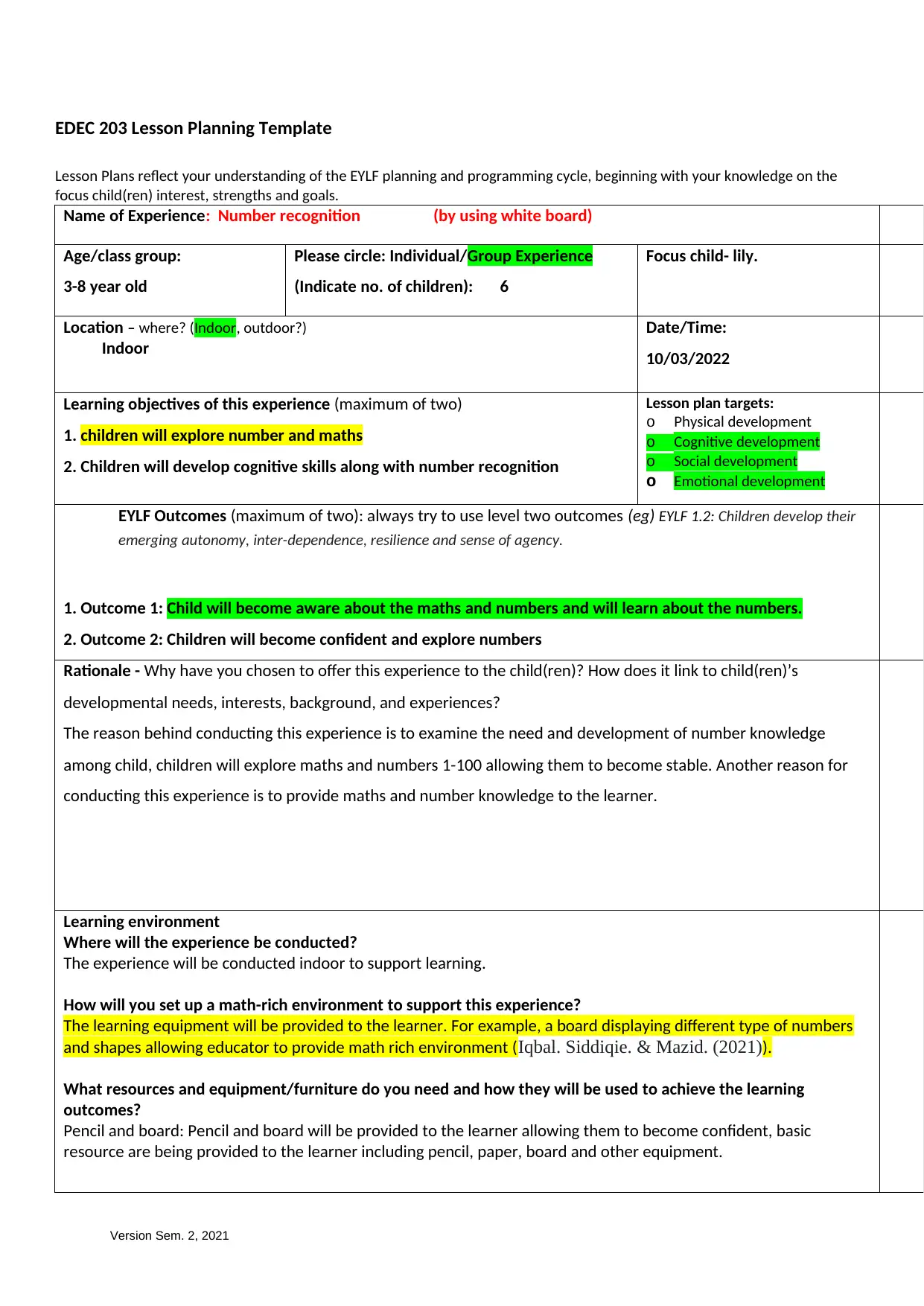
EDEC 203 Lesson Planning Template
Lesson Plans reflect your understanding of the EYLF planning and programming cycle, beginning with your knowledge on the
focus child(ren) interest, strengths and goals.
Name of Experience: Number recognition (by using white board)
Age/class group:
3-8 year old
Please circle: Individual/Group Experience
(Indicate no. of children): 6
Focus child- lily.
Location – where? (Indoor, outdoor?)
Indoor
Date/Time:
10/03/2022
Learning objectives of this experience (maximum of two)
1. children will explore number and maths
2. Children will develop cognitive skills along with number recognition
Lesson plan targets:
o Physical development
o Cognitive development
o Social development
o Emotional development
EYLF Outcomes (maximum of two): always try to use level two outcomes (eg) EYLF 1.2: Children develop their
emerging autonomy, inter-dependence, resilience and sense of agency.
1. Outcome 1: Child will become aware about the maths and numbers and will learn about the numbers.
2. Outcome 2: Children will become confident and explore numbers
Rationale - Why have you chosen to offer this experience to the child(ren)? How does it link to child(ren)’s
developmental needs, interests, background, and experiences?
The reason behind conducting this experience is to examine the need and development of number knowledge
among child, children will explore maths and numbers 1-100 allowing them to become stable. Another reason for
conducting this experience is to provide maths and number knowledge to the learner.
Learning environment
Where will the experience be conducted?
The experience will be conducted indoor to support learning.
How will you set up a math-rich environment to support this experience?
The learning equipment will be provided to the learner. For example, a board displaying different type of numbers
and shapes allowing educator to provide math rich environment (Iqbal. Siddiqie. & Mazid. (2021)).
What resources and equipment/furniture do you need and how they will be used to achieve the learning
outcomes?
Pencil and board: Pencil and board will be provided to the learner allowing them to become confident, basic
resource are being provided to the learner including pencil, paper, board and other equipment.
Version Sem. 2, 2021
Lesson Plans reflect your understanding of the EYLF planning and programming cycle, beginning with your knowledge on the
focus child(ren) interest, strengths and goals.
Name of Experience: Number recognition (by using white board)
Age/class group:
3-8 year old
Please circle: Individual/Group Experience
(Indicate no. of children): 6
Focus child- lily.
Location – where? (Indoor, outdoor?)
Indoor
Date/Time:
10/03/2022
Learning objectives of this experience (maximum of two)
1. children will explore number and maths
2. Children will develop cognitive skills along with number recognition
Lesson plan targets:
o Physical development
o Cognitive development
o Social development
o Emotional development
EYLF Outcomes (maximum of two): always try to use level two outcomes (eg) EYLF 1.2: Children develop their
emerging autonomy, inter-dependence, resilience and sense of agency.
1. Outcome 1: Child will become aware about the maths and numbers and will learn about the numbers.
2. Outcome 2: Children will become confident and explore numbers
Rationale - Why have you chosen to offer this experience to the child(ren)? How does it link to child(ren)’s
developmental needs, interests, background, and experiences?
The reason behind conducting this experience is to examine the need and development of number knowledge
among child, children will explore maths and numbers 1-100 allowing them to become stable. Another reason for
conducting this experience is to provide maths and number knowledge to the learner.
Learning environment
Where will the experience be conducted?
The experience will be conducted indoor to support learning.
How will you set up a math-rich environment to support this experience?
The learning equipment will be provided to the learner. For example, a board displaying different type of numbers
and shapes allowing educator to provide math rich environment (Iqbal. Siddiqie. & Mazid. (2021)).
What resources and equipment/furniture do you need and how they will be used to achieve the learning
outcomes?
Pencil and board: Pencil and board will be provided to the learner allowing them to become confident, basic
resource are being provided to the learner including pencil, paper, board and other equipment.
Version Sem. 2, 2021
Paraphrase This Document
Need a fresh take? Get an instant paraphrase of this document with our AI Paraphraser
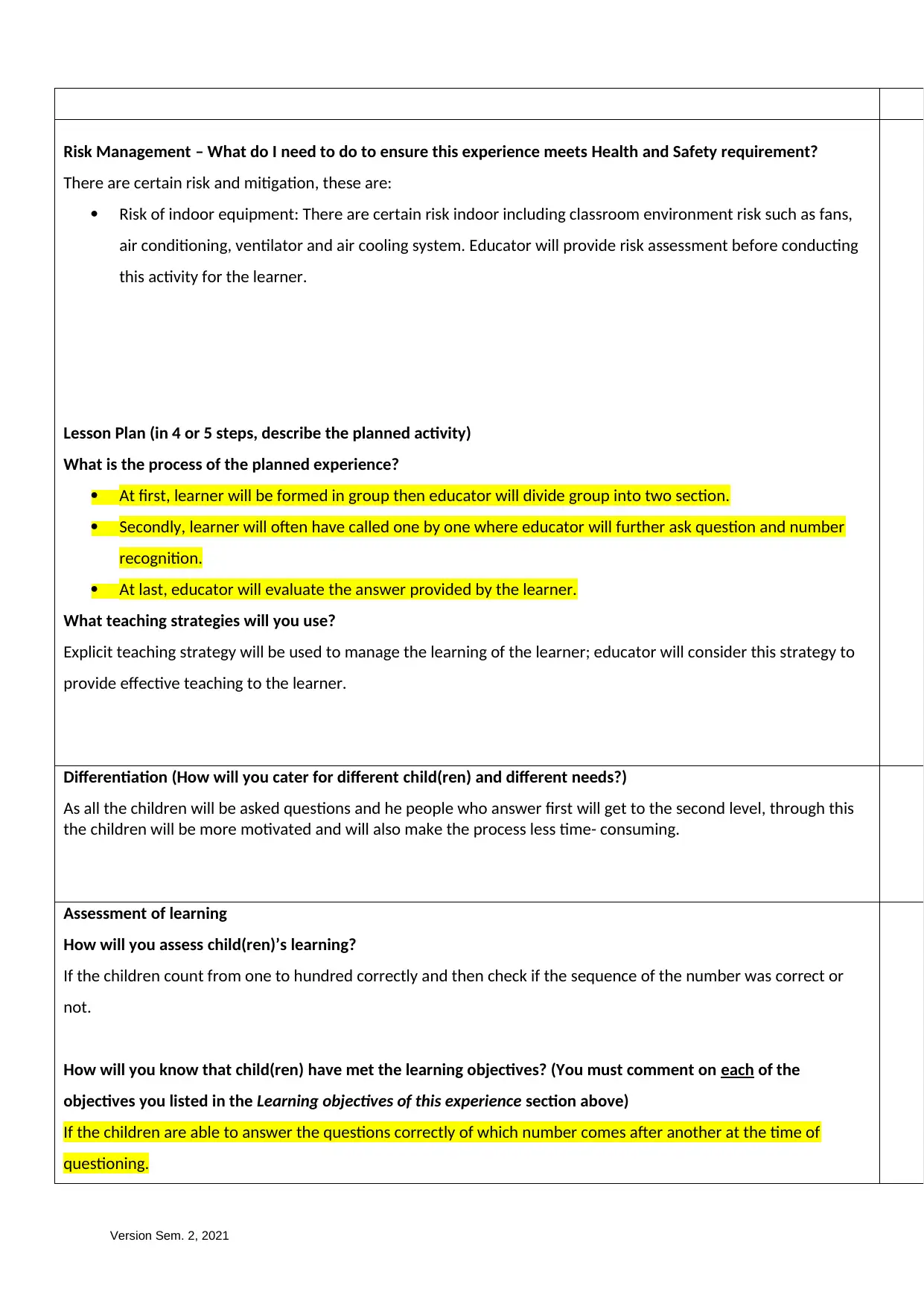
Risk Management – What do I need to do to ensure this experience meets Health and Safety requirement?
There are certain risk and mitigation, these are:
Risk of indoor equipment: There are certain risk indoor including classroom environment risk such as fans,
air conditioning, ventilator and air cooling system. Educator will provide risk assessment before conducting
this activity for the learner.
Lesson Plan (in 4 or 5 steps, describe the planned activity)
What is the process of the planned experience?
At first, learner will be formed in group then educator will divide group into two section.
Secondly, learner will often have called one by one where educator will further ask question and number
recognition.
At last, educator will evaluate the answer provided by the learner.
What teaching strategies will you use?
Explicit teaching strategy will be used to manage the learning of the learner; educator will consider this strategy to
provide effective teaching to the learner.
Differentiation (How will you cater for different child(ren) and different needs?)
As all the children will be asked questions and he people who answer first will get to the second level, through this
the children will be more motivated and will also make the process less time- consuming.
Assessment of learning
How will you assess child(ren)’s learning?
If the children count from one to hundred correctly and then check if the sequence of the number was correct or
not.
How will you know that child(ren) have met the learning objectives? (You must comment on each of the
objectives you listed in the Learning objectives of this experience section above)
If the children are able to answer the questions correctly of which number comes after another at the time of
questioning.
Version Sem. 2, 2021
There are certain risk and mitigation, these are:
Risk of indoor equipment: There are certain risk indoor including classroom environment risk such as fans,
air conditioning, ventilator and air cooling system. Educator will provide risk assessment before conducting
this activity for the learner.
Lesson Plan (in 4 or 5 steps, describe the planned activity)
What is the process of the planned experience?
At first, learner will be formed in group then educator will divide group into two section.
Secondly, learner will often have called one by one where educator will further ask question and number
recognition.
At last, educator will evaluate the answer provided by the learner.
What teaching strategies will you use?
Explicit teaching strategy will be used to manage the learning of the learner; educator will consider this strategy to
provide effective teaching to the learner.
Differentiation (How will you cater for different child(ren) and different needs?)
As all the children will be asked questions and he people who answer first will get to the second level, through this
the children will be more motivated and will also make the process less time- consuming.
Assessment of learning
How will you assess child(ren)’s learning?
If the children count from one to hundred correctly and then check if the sequence of the number was correct or
not.
How will you know that child(ren) have met the learning objectives? (You must comment on each of the
objectives you listed in the Learning objectives of this experience section above)
If the children are able to answer the questions correctly of which number comes after another at the time of
questioning.
Version Sem. 2, 2021
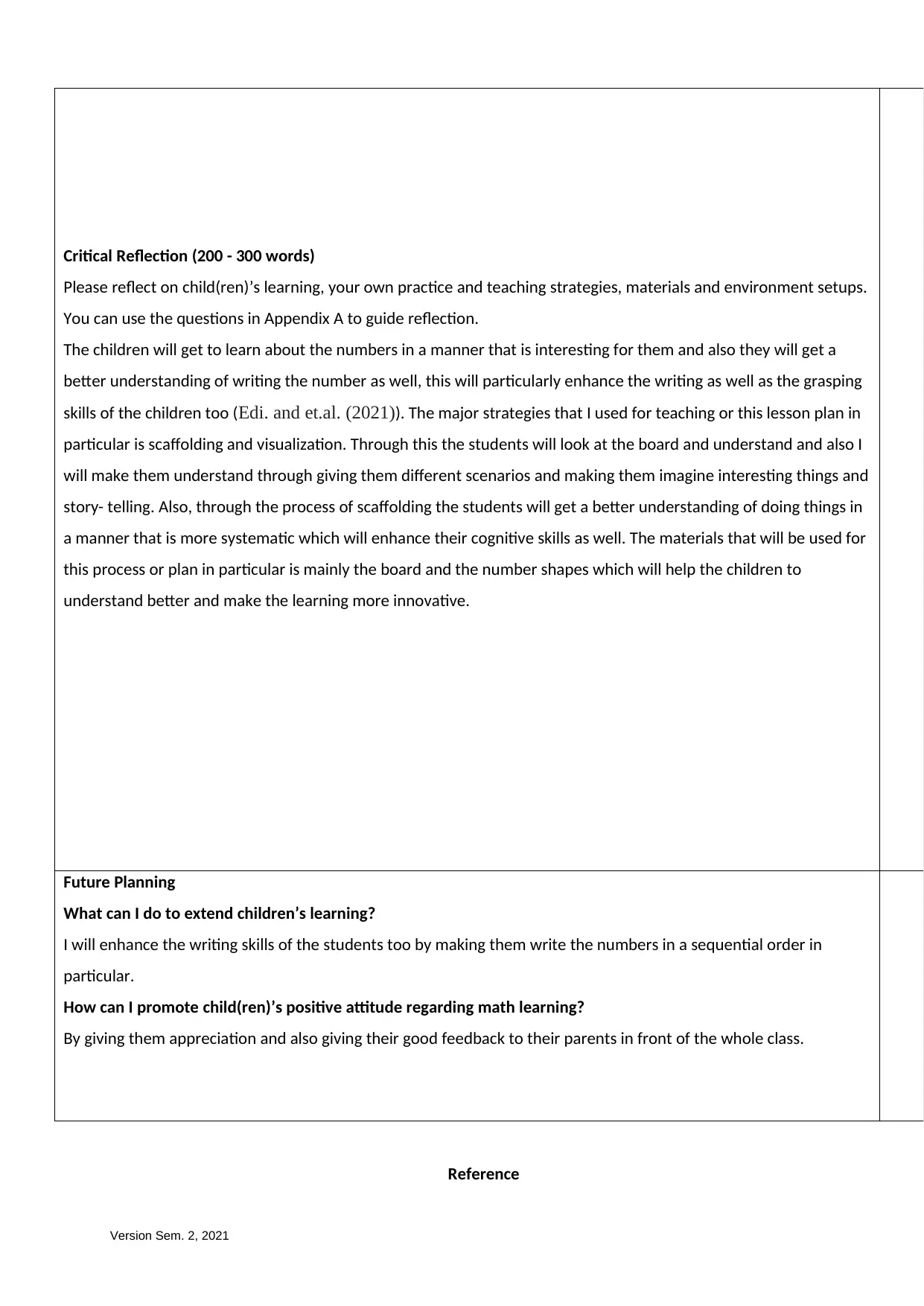
Critical Reflection (200 - 300 words)
Please reflect on child(ren)’s learning, your own practice and teaching strategies, materials and environment setups.
You can use the questions in Appendix A to guide reflection.
The children will get to learn about the numbers in a manner that is interesting for them and also they will get a
better understanding of writing the number as well, this will particularly enhance the writing as well as the grasping
skills of the children too (Edi. and et.al. (2021)). The major strategies that I used for teaching or this lesson plan in
particular is scaffolding and visualization. Through this the students will look at the board and understand and also I
will make them understand through giving them different scenarios and making them imagine interesting things and
story- telling. Also, through the process of scaffolding the students will get a better understanding of doing things in
a manner that is more systematic which will enhance their cognitive skills as well. The materials that will be used for
this process or plan in particular is mainly the board and the number shapes which will help the children to
understand better and make the learning more innovative.
Future Planning
What can I do to extend children’s learning?
I will enhance the writing skills of the students too by making them write the numbers in a sequential order in
particular.
How can I promote child(ren)’s positive attitude regarding math learning?
By giving them appreciation and also giving their good feedback to their parents in front of the whole class.
Reference
Version Sem. 2, 2021
Please reflect on child(ren)’s learning, your own practice and teaching strategies, materials and environment setups.
You can use the questions in Appendix A to guide reflection.
The children will get to learn about the numbers in a manner that is interesting for them and also they will get a
better understanding of writing the number as well, this will particularly enhance the writing as well as the grasping
skills of the children too (Edi. and et.al. (2021)). The major strategies that I used for teaching or this lesson plan in
particular is scaffolding and visualization. Through this the students will look at the board and understand and also I
will make them understand through giving them different scenarios and making them imagine interesting things and
story- telling. Also, through the process of scaffolding the students will get a better understanding of doing things in
a manner that is more systematic which will enhance their cognitive skills as well. The materials that will be used for
this process or plan in particular is mainly the board and the number shapes which will help the children to
understand better and make the learning more innovative.
Future Planning
What can I do to extend children’s learning?
I will enhance the writing skills of the students too by making them write the numbers in a sequential order in
particular.
How can I promote child(ren)’s positive attitude regarding math learning?
By giving them appreciation and also giving their good feedback to their parents in front of the whole class.
Reference
Version Sem. 2, 2021
⊘ This is a preview!⊘
Do you want full access?
Subscribe today to unlock all pages.

Trusted by 1+ million students worldwide
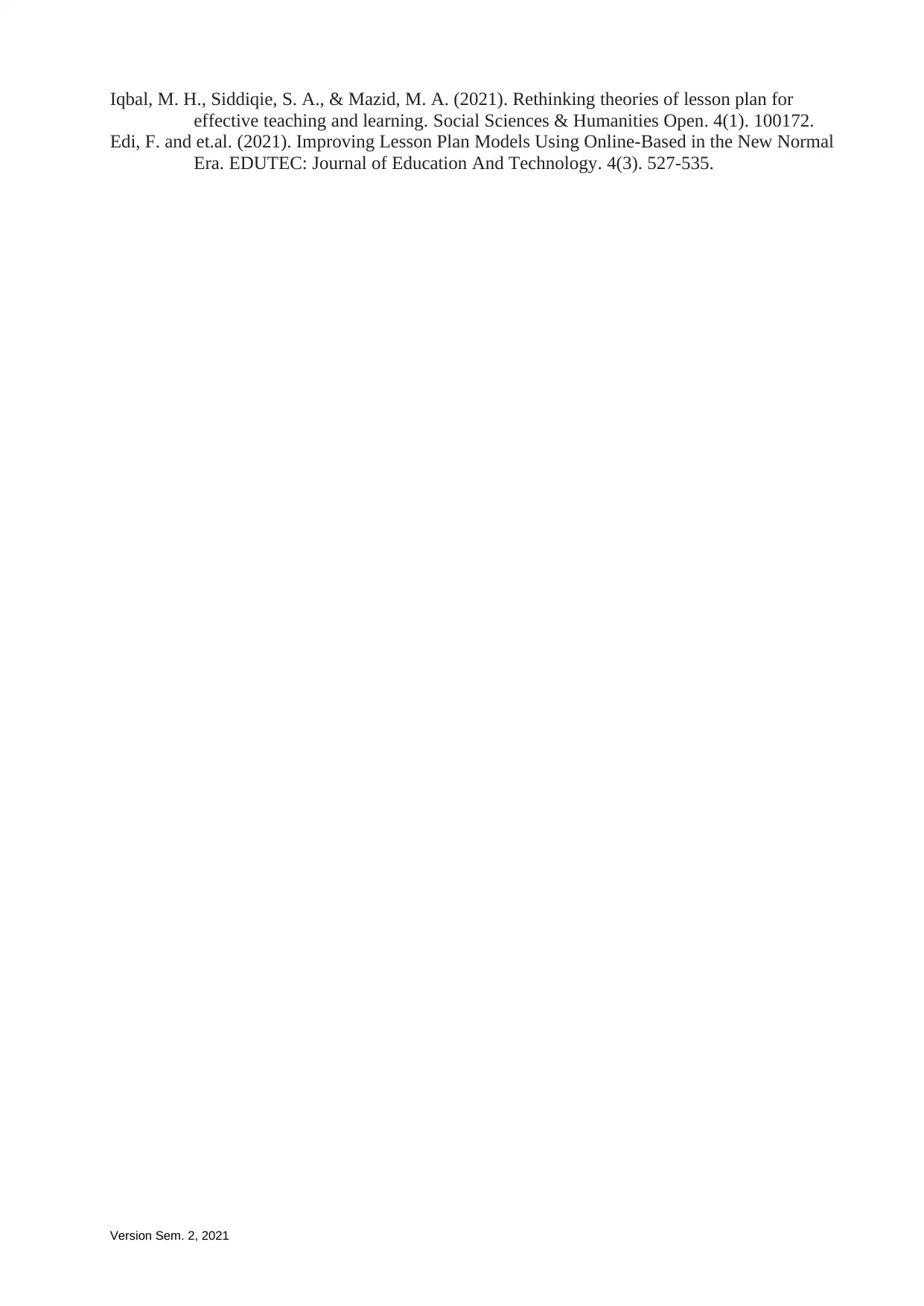
Iqbal, M. H., Siddiqie, S. A., & Mazid, M. A. (2021). Rethinking theories of lesson plan for
effective teaching and learning. Social Sciences & Humanities Open. 4(1). 100172.
Edi, F. and et.al. (2021). Improving Lesson Plan Models Using Online-Based in the New Normal
Era. EDUTEC: Journal of Education And Technology. 4(3). 527-535.
Version Sem. 2, 2021
effective teaching and learning. Social Sciences & Humanities Open. 4(1). 100172.
Edi, F. and et.al. (2021). Improving Lesson Plan Models Using Online-Based in the New Normal
Era. EDUTEC: Journal of Education And Technology. 4(3). 527-535.
Version Sem. 2, 2021
Paraphrase This Document
Need a fresh take? Get an instant paraphrase of this document with our AI Paraphraser
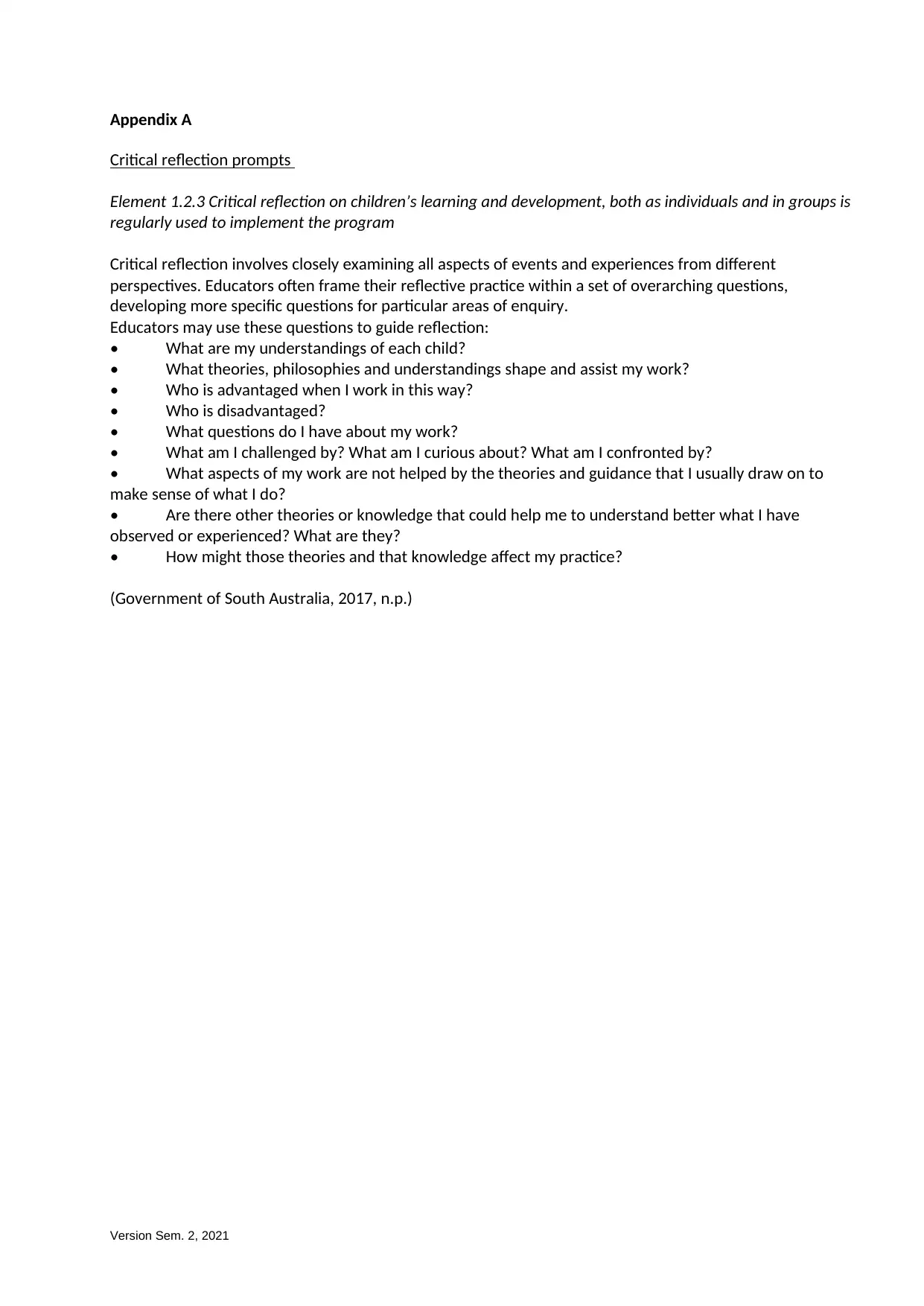
Appendix A
Critical reflection prompts
Element 1.2.3 Critical reflection on children’s learning and development, both as individuals and in groups is
regularly used to implement the program
Critical reflection involves closely examining all aspects of events and experiences from different
perspectives. Educators often frame their reflective practice within a set of overarching questions,
developing more specific questions for particular areas of enquiry.
Educators may use these questions to guide reflection:
• What are my understandings of each child?
• What theories, philosophies and understandings shape and assist my work?
• Who is advantaged when I work in this way?
• Who is disadvantaged?
• What questions do I have about my work?
• What am I challenged by? What am I curious about? What am I confronted by?
• What aspects of my work are not helped by the theories and guidance that I usually draw on to
make sense of what I do?
• Are there other theories or knowledge that could help me to understand better what I have
observed or experienced? What are they?
• How might those theories and that knowledge affect my practice?
(Government of South Australia, 2017, n.p.)
Version Sem. 2, 2021
Critical reflection prompts
Element 1.2.3 Critical reflection on children’s learning and development, both as individuals and in groups is
regularly used to implement the program
Critical reflection involves closely examining all aspects of events and experiences from different
perspectives. Educators often frame their reflective practice within a set of overarching questions,
developing more specific questions for particular areas of enquiry.
Educators may use these questions to guide reflection:
• What are my understandings of each child?
• What theories, philosophies and understandings shape and assist my work?
• Who is advantaged when I work in this way?
• Who is disadvantaged?
• What questions do I have about my work?
• What am I challenged by? What am I curious about? What am I confronted by?
• What aspects of my work are not helped by the theories and guidance that I usually draw on to
make sense of what I do?
• Are there other theories or knowledge that could help me to understand better what I have
observed or experienced? What are they?
• How might those theories and that knowledge affect my practice?
(Government of South Australia, 2017, n.p.)
Version Sem. 2, 2021
1 out of 5
Related Documents
Your All-in-One AI-Powered Toolkit for Academic Success.
+13062052269
info@desklib.com
Available 24*7 on WhatsApp / Email
![[object Object]](/_next/static/media/star-bottom.7253800d.svg)
Unlock your academic potential
Copyright © 2020–2025 A2Z Services. All Rights Reserved. Developed and managed by ZUCOL.




